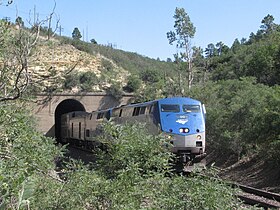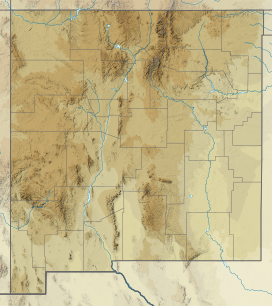| Ratón Pass | |
|---|---|
 Amtrak's Southwest Chief westbound out of the Raton Tunnel near the summit of Raton Pass | |
| Elevation | 7,834 ft (2,388 m) |
| Traversed by | Burlington Northern Santa Fe Railroad |
| Location | Colfax County, New Mexico and Las Animas County, Colorado, US |
| Coordinates | 36°59′28″N 104°29′12″W / 36.9911344°N 104.4866544°W[1] |
| Topo map | Ratón |
Raton Pass | |
 Looking north from the top of Raton Pass | |
| Nearest city | Trinidad, Colorado, Raton, New Mexico |
| Area | 1,520 acres (620 ha) |
| Built | 1866 |
| NRHP reference No. | 66000474[2] |
| CSRHP No. | 5LA.2182[3] |
| Significant dates | |
| Added to NRHP | October 15, 1966 |
| Designated NHL | December 19, 1960[4] |
Ratón Pass is a 7,834 ft (2,388 m) elevation mountain pass on the Colorado–New Mexico border in the western United States. It is located on the eastern side of the Sangre de Cristo Mountains between Trinidad, Colorado and Raton, New Mexico, approximately 180 miles (290 km) northeast of Santa Fe. Ratón is Spanish for "mouse". The pass crosses the line of volcanic mesas that extends east from the Sangre de Cristo Mountains along the state line, and furnishes the most direct land route between the valley of the Arkansas River to the north and the upper valley of the Canadian River, leading toward Santa Fe, to the south. The pass now carries Interstate 25 and railroad tracks.
The pass is a historically significant landmark on the Santa Fe Trail, a major 19th-century settlement route between Kansas City, Missouri and Santa Fe. It was designated a National Historic Landmark in 1960 for this association.
- ^ "Ratón Pass". Geographic Names Information System. United States Geological Survey, United States Department of the Interior. Retrieved January 3, 2010.
- ^ "National Register Information System". National Register of Historic Places. National Park Service. July 9, 2010.
- ^ "State Register of Historic Properties, Las Animas County". Office of Archaeology and Historic Preservation. Archived from the original on December 20, 2016. Retrieved December 9, 2016.
- ^ "Raton Pass". National Historic Landmark summary listing. National Park Service. Archived from the original on June 6, 2011. Retrieved October 13, 2007.

